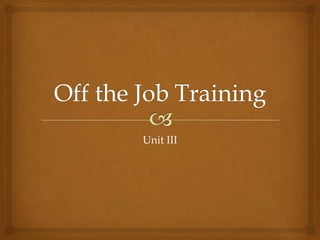Off the job training
- 1. Unit III
- 2. Off the Job Training Methods Vestibule Training Lectures Audio-Visuals Special Study Programmed Instructions Computer Aided Instruction Simulation Case Study Role-Playing Sensitivity Training Discussion Method Demonstration Brainstorming Field Trip
- 3. Uses equipment which closely resembles the actual ones on the job A special area or room is set aside from work environment Trainee is permitted to learn under simulated conditions No pressure to produce while learning Duplicate facilities and trainer cost are disadvantages Vestibule training
- 4. Verbal presentation by an instructor Lecturer should have considerable knowkedge in training area Used for very large groups Used in colleges & Univ. – application restricted in training factory employees Lectures
- 5. AV includes television slides, OHPs and films Provide wide range of realistic examples and job conditions One-way system of communication Audio - Visuals
- 6. Programmed Instruction (PI) Training is offered without intervention of a trainer Information provided thru blocks, books or thru teaching machine After reading each block of material, learner should answer questions about it Feedback in the form of correct answers is provided after each response Present questions & facts/problems – allow trainee to respond – provide feedback on accuracy – if answer is correct, allow trainee to proceed to next block Special Study
- 7. Computer Aided Instructions (CAI) Extension of PI method The speed, memory and data-manipulation capabilities of computer permit greater utilisation of basic PI concept Learner’s response may determine the frequency and difficulty level of next frame Special Study (CONT..)
- 8. A Simulator is any kind of equipment or technique that duplicates as nearly as possible the actual conditions encountered on the job Attempt to create realistic decision-making environment for trainee Ex: Activities of an organization may be simulated and trainee may be asked to make a decision in support of those activities Feed back on decision is given Learning pace is created Widely used simulations are – Vestibule training, case study, role play Simulation
- 9. Written description of an actual situation Provokes reader with the need to decide on what is going on What the situation really is? Or what the problems are? And what should be done? Cases are attempts to describe in accurate the real problems faced by managers – trainees can determine problems – analyze causes – develop alternative solutions – select best one and implement it Excellent opportunity for individuals to defend their analytical and judgmental abilities Case Study
- 10. Focuses on emotional (human relations) issues rather than actual ones Essence of role playing is to create a realistic situation as in case study Have the trainees assume the parts of specific personalities in the situation Role Playing
- 11. ST uses small no. of trainees (less than 12) Meet with a passive trainer and gain insight into their own & other's behavior Meetings have no agenda – held away from workplace Questions deal with “here & now” of the group process Discussions focus on “why participants behave as they do, how they perceive one another and the feelings and emotions generated in the interaction process” Other names Laboratory training Encounter Groups T- Groups (Training Groups) Sensitivity Training
- 12. To provide participants with increased awareness of their own behavior and how others perceive them To provide greater sensitivity to the behaviors of others, and increased understanding of group processes Specific results Increased ability to emphasize with others Improved listening skills Greater openness Increased tolerance of individual differences Increased conflict resolution skills Objectives of ST
- 13. Once the training is over, the participants are themselves again They resort to their old habits Disadvantages of ST
- 14. A lecturer uses this method to support, elaborate, explain, expand or interact Improves two way communication Discussion
- 15. Physical display of form, outline or substance of an object/ event In laboratories In shop floors Demonstration
- 16. Idea generation method Creative solution to problems Trainees should deliberately come out with different solutions to a problem Not only come out with ideas but also spark off from associations with other people's ideas by developing and refining them Brainstorming
- 17. A field work or FT is a journey by a group of people to place away from a normal environment Purpose of trip will be – Observation for education Non-experimental research Provide experience outside normal everyday activity Field Trip

